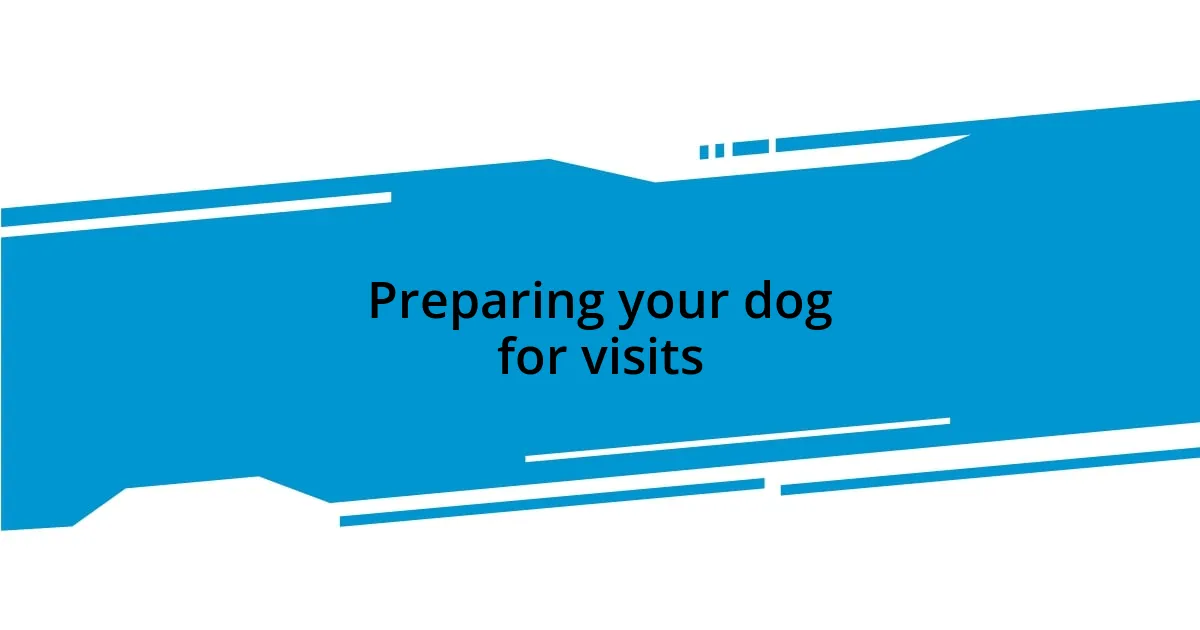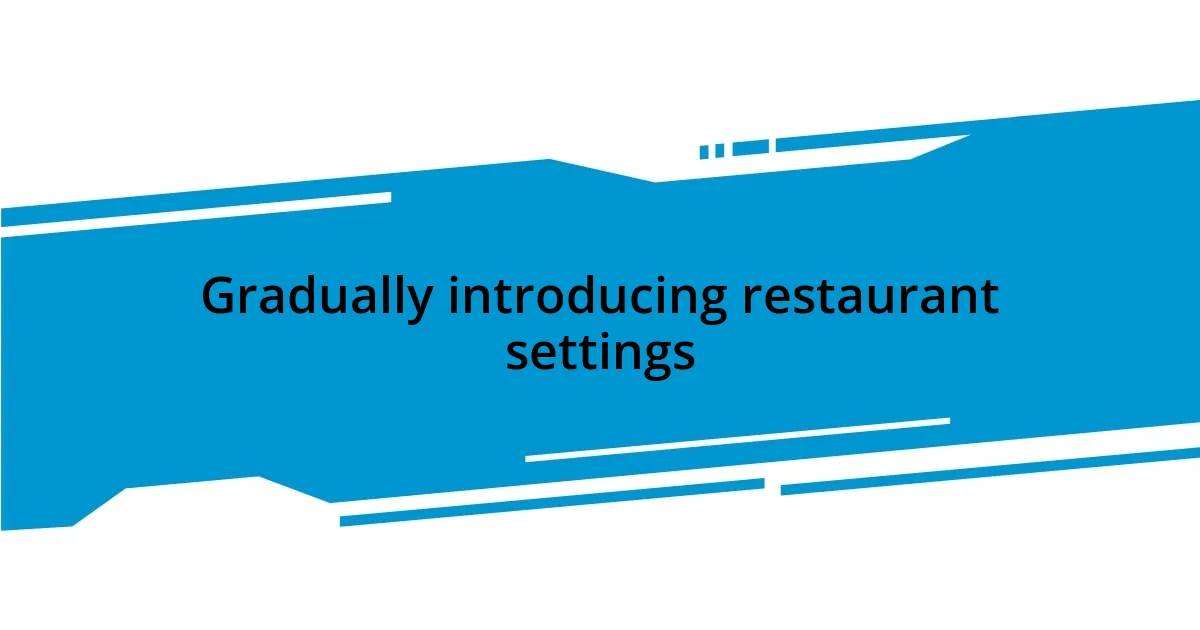Key takeaways:
- Basic commands like “sit,” “stay,” and “down” are essential for training dogs to behave in restaurant settings and build trust between the dog and owner.
- Socialization in varied environments helps dogs adapt to new experiences, making them more comfortable in busy public spaces.
- Positive reinforcement, such as treats and praise, is crucial during and after visits to reinforce good behavior and create positive associations.
- Gradual exposure to restaurant settings, starting with less busy times, helps dogs acclimate and reduces anxiety related to new environments.

Preparing your dog for visits
One of the first steps I took when preparing my dog for restaurant visits was practicing basic commands like sit, stay, and down. I’d set up mini training sessions at home, rewarding my pup with treats and praise when she followed my commands. I found that this not only reinforced her behavior but also built a strong bond of trust between us. Have you experienced how a simple treat can turn an ordinary moment into a joyful interaction?
I also familiarized her with the sights and sounds of a busy restaurant environment. We made trips to busy parks and other social settings, gradually easing her into the hustle and bustle. I remember the first time we encountered loud noises; her ears perked up, but after a few reassuring words and gentle pets, she settled down. Isn’t it incredible how quickly dogs can adapt when they feel secure?
Lastly, socialization played a crucial role in our preparation. I invited friends with dogs over for playdates and went on group walks, helping my pup learn to interact calmly with other dogs and people. The more experiences she had, the more comfortable she became during our outings. Have you noticed how a well-socialized dog tends to be more relaxed in new situations? I truly believe that these moments shaped her into the excellent restaurant companion she is today.

Understanding restaurant etiquette
Understanding restaurant etiquette starts with teaching your dog how to behave in a public space. I remember the first time I took my dog to a café; she was excited to see all the sights and smells. But with a gentle reminder to stay calm, she quickly learned that sitting quietly was her ticket to enjoying a little treat from my plate. It’s fascinating how dogs pick up on expectations with consistent training, isn’t it?
Moreover, I’ve noticed that understanding personal space is vital. On one occasion, we were seated near a family with small children. My dog instinctively leaned towards them, eager to make new friends. I quickly recalled the importance of keeping her close to me and ensuring she respected the boundaries of others. This not only kept her relaxed but also made for a more enjoyable dining experience for everyone.
Finally, observing the restaurant staff is crucial. I learned to help my dog understand that not everyone wants to interact. On a trip to a dog-friendly venue, I encouraged her to watch how I responded to the waitstaff. Each time they approached, I rewarded her quiet demeanor with praise. I could see how each positive interaction reinforced her understanding of appropriate behavior in different settings.
| Behavior | Expected Action |
|---|---|
| Staying Calm | Sit quietly while at the table |
| Respecting Personal Space | Avoid rushing towards other guests |
| Observing Staff | Remain composed when approached by waitstaff |

Training basic commands at home
Training basic commands at home can be a fun yet rewarding experience. I remember the first day I taught my dog to “sit.” I used her favorite treats as motivation, and I could see her excitement build as she caught on quickly. That moment of understanding, when she finally obeyed on the first try, filled me with such joy! Watching her respond positively to a simple cue made me realize how much trust we were building.
Here are some essential commands to focus on during your training sessions:
- Sit: A foundational command that promotes calmness.
- Stay: Encourages patience and teaches boundaries.
- Down: Helps your dog settle in busy environments.
I have found that consistent practice in a familiar setting sets the stage for smoother outings later. Each command learned becomes a stepping stone toward enjoying our adventures together. The bond that forms through this process is incredibly rewarding, enriching both of our lives.

Socializing your dog in public
Socializing your dog in public is a balancing act between exposure and comfort. I vividly recall taking my dog to a local park for the first time. She was overwhelmed by all the new sights, sounds, and, oh, the smells! I realized that allowing her to explore at her own pace was essential. It was fascinating to watch her gain confidence as she met other dogs and people. Isn’t it incredible how these experiences shape their behavior over time?
One of the key lessons I learned while navigating public spaces was the importance of positive reinforcement. During a visit to a bustling outdoor market, my dog became a little anxious with the crowds. I started rewarding her with treats when she remained calm amidst the chaos. That day, she learned that staying close to me and ignoring distractions would earn her not just treats but also my praise. Have you ever seen how a simple reward can transform a dog’s outlook?
It’s also vital to create controlled environments for socializing. I began taking my dog to quieter times at the local café, slowly introducing her to the experience without overwhelming her. This gradual exposure helped her associate good feelings with being out in public. I love how dogs, with all their enthusiasm, can also teach us patience. When was the last time you saw pure joy in a little moment, just like your pup does?

Gradually introducing restaurant settings
When I started introducing my dog to restaurant settings, I took things slow. The first step was simply visiting the outdoor seating area of a pet-friendly café. I remember how nervous I felt as we sat down—would she behave? To my surprise, she curled up at my feet, seemingly enjoying the atmosphere. This initial outing helped reinforce the idea that restaurants could be relaxing spaces rather than overwhelming ones.
As we progressed, I made it a point to choose times when the restaurant wasn’t too busy. We visited during off-peak hours, allowing my dog to adapt without the pressure of a crowded environment. I also brought along her favorite blanket, which helped her feel secure. It’s amazing how a familiar item can ease anxiety! Have you ever noticed how quickly dogs pick up on their surroundings? It’s as if they’re always analyzing the scene for cues on how to act.
Eventually, we moved to busier times, but I was proactive in my approach. I engaged my dog with commands and rewards right from the start, making each restaurant visit a training opportunity. I’d ask her to “sit” or “stay” before we even entered, reinforcing her training. Watching her thrive in a setting that once seemed daunting filled me with pride. Don’t you find joy in seeing your dog flourish in new situations? These small victories reminded me why I love training her in the first place.

Managing behavior during meals
Managing behavior during meals can feel like a dance between discipline and understanding. I remember my first restaurant visit with my dog where, mid-meal, she decided it was a prime moment to test my patience by letting out a gentle whine. Instead of succumbing to embarrassment, I took a deep breath and gently redirected her focus to a chew toy I had tucked away. The way she settled back down felt like a small victory—who knew a toy could become our peacekeeper during dining?
During our meals, I established clear expectations for her behavior. In one instance, I noticed she was getting restless as the plates around us filled with food. I calmly placed my hand on her back and whispered “stay.” It was as if a switch flipped; she understood that staying calm meant more time enjoying our outings. Have you ever felt the shift in your dog’s energy when they catch on to the rules? It’s truly rewarding to see that understanding blossom.
I also found that bringing special treats made a world of difference in managing her excitement. On one visit, I surprised her with a favorite chewy snack just as the aroma of our meals wafted by. Suddenly, the food wasn’t the center of her world anymore. Instead, she watched and waited for her turn. Those precious moments reinforced my belief that with the right tools and positive reinforcement, we could turn any dining experience into a delightful adventure. Don’t you think that when we focus on training with love, every outing can become an opportunity for growth?

Reinforcing positive experiences after visits
After each restaurant visit, I made sure to reinforce the positive experiences my dog had. The moment we returned home, I would shower her with praise and give her a treat—something special, like a small piece of chicken. It made me smile to see her tail wagging furiously; she seemed to understand that our outings were a success! Have you ever noticed how a simple treat can change your dog’s entire demeanor? It’s as if they’re saying, “Yes, I did good!”
On particularly successful outings, I’d take it a step further by recreating a mini celebration at home. We’d snuggle on the couch while I leisurely reviewed our day, tossing in a few extra pets and gentle scratches behind her ears. I found that dogs thrive on this kind of emotional connection. It was a special bonding moment for both of us—do you see the way love and recognition can reinforce positive behavior in dogs?
I also kept a little journal of our restaurant visits to track her progress. This way, I could reflect on the small victories and celebrate milestones, like the time she remained calm at the table for a full hour! Writing it down made it feel more real and gave me a tangible record of how far we’d come. Sometimes, I’d read past entries aloud to her, imagining she could appreciate the praise just as much as I did. Isn’t it incredible how our journeys together can transform into cherished memories?
















